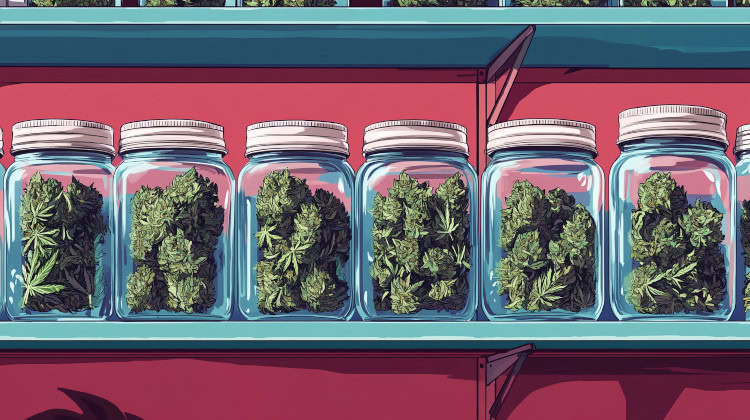In This Article
- Comparing Smoking, Vaping, Edibles, and Other Options
- Who to Ask for Advice?
- How to Research Products Online
- The Trial-and-Error Process of Finding the Right Strain
- Factors Patients Should Consider
- What Factors Should Patients Consider When Picking Edibles?
- How Should Patients Go About Choosing Vapes and Concentrates?
- When Should Patients Consider Other Types of Products?
- Additional Information: Indica vs. Sativa vs. Hybrid
- References
Key Takeaways
- Finding the ideal cannabis strain or product involves understanding desired effects, doing thorough research, and having a willingness to experiment.
- Seek guidance from knowledgeable sources like cannabis doctors, pharmacists, and experienced budtenders.
- Carefully consider consumption methods, potency levels, terpene profiles, and cannabinoid ratios when choosing products.
Finding the ideal strain or cannabis product has the potential to significantly influence the experience.
For some medical cannabis patients, choosing the correct strain is a central part of the process. For recreational consumers, the right strain can create an optimal experience that feels tailored to their mood or activity.
Comparing Smoking, Vaping, Edibles, and Other Options

Exploring different consumption methods helps consumers find the most compatible with their health needs, lifestyle, and desired outcomes.
Consider the cannabis consumption methods available and how they might influence experiences.
- Smoking: Rapid onset, often providing immediate effects. Smoke inhalation, however, may be harsh on the lungs, posing long-term respiratory health concerns.
- Vaping: Rapid onset similar to smoking but with smoother inhalation, potentially fewer harmful toxins, and a higher potency than flower. Some studies suggest that vaping flower presents the lowest safety risk compared to other inhalable methods.1
- Edibles: Long-lasting and potent effects with a delayed onset, varying between 15 minutes and 2 hours depending on the product. Edibles are perfect for sustained effects without smoking.
Who to Ask for Advice?

Choosing the ideal strains and products requires personalized guidance from one or more knowledgeable resources, such as:
- Cannabis Doctors: Licensed physicians specializing in medical cannabis can offer tailored advice. Doctors factor in the individual’s medical history, symptoms, treatment goals, and consumption preferences to determine the best options.
- Cannabis Pharmacists: Trained professionals capable of providing expert dosage advice, explaining interactions with other medications, and offering insights into cannabinoid and terpene profiles.
- Budtenders: Dispensary staff who offer practical recommendations based on firsthand experience, customer feedback, and detailed knowledge of various cannabis products. While many budtenders are informed, verify their recommendations with one of the above sources whenever possible.
- Friends, Family, and Similar Patients: Receive anecdotal insights and practical tips based on personal experience, though individual reactions may vary. Much like budtenders, it’s wise to compare such advice with that from medical professionals.
How to Research Products Online
Thorough online research helps identify the ideal strains and products. When considering what to buy online, check the following sources:
- Trusted Information Platforms: Resources like NuggMD provide ample access to credible educational content and user testimonials. Patients can connect with medical professionals for informed, customized insights.
- Dispensary Websites: Review detailed product descriptions, cannabinoid profiles, potency information, and customer reviews to gauge product suitability. However, these reviews can be skewed when hosted by the brand itself. Always verify that retailers are licensed by checking official government resources.
- Cannabis Databases and Review Sites: These offer extensive user reviews, strain information, and reported effects, all hosted on a non-branded platform.
- Academic and Government Resources: Data from research institutions and government health organizations provides evidence-based insights into cannabis effects and safety.
The Trial-and-Error Process of Finding the Right Strain
Discovering the ideal cannabis strain or product is often an ongoing process. Most consumers try several strains and product types before identifying the ideal match.
Keeping a detailed cannabis journal is helpful for many. Consumers can record strain names, dosages, consumption methods, and personal experiences. These details help consumers and their trusted medical professionals spot patterns and refine choices as needed.
Factors Patients Should Consider
- Desired Effects: Identify the desired effects and look for anecdotal reports that match these effects. These are just a starting point as personal reactions are unique. Try keeping a journal to document each new strain or product.
- Flavor Profiles and Terpenes: Aromatic and flavor preferences play a huge part in the experience, with terpenes significantly impacting both taste, smell, and experience.2
- Cannabinoid Ratios: Balance between THC and CBD, which helps determine intensity and overall experience. In a preliminary 2020 study, researchers noted that prose recall was higher in participants after consuming cannabis high in CBD than those using cannabis that was low in CBD. Other studies have investigated whether CBD may lessen THC-related learning and memory impairments.3 Keep in mind that this research is still in its earliest stages and conflicting reports exist. Still, it's worth considering balance.
- Tolerance Levels: Individual sensitivity to cannabinoids influences the optimal dosage and product potency.
- Usage Context: Setting, time of day, and intended activities all play an important role in the effect created.
What Factors Should Patients Consider When Picking Edibles?

Selecting edibles requires particular attention to several key factors:
- Dosage and Potency: Beginners may want to start with small, controlled dosages to gauge tolerance and sensitivity. Many consumers start with doses as small as 2.5mg.
- Onset Time and Duration: Edibles have delayed effects due to digestion, with effects lasting significantly longer than inhaled cannabis. It’s important that consumers wait 30 to 90 minutes before deciding if another dose is needed. Otherwise they risk the adverse effects of overconsumption.
- Ingredients and Dietary Restrictions: Always check for allergens, vegan, gluten-free, or other dietary considerations to ensure compatibility.
- Certificate of Authenticity: If purchased online or in a dispensary, products should come from licensed brands with links to passed third-party lab tests that confirm the product’s contents.
How Should Patients Go About Choosing Vapes and Concentrates?

Choosing vapes and concentrates involves careful consideration of:
- Product Potency: Concentrates typically offer THC levels of 60-90%, requiring careful, gradual dosing to avoid overconsumption.
- Extraction Method: CO2 extraction, BHO extraction, and solventless methods affect purity, consistency, flavor, aroma, and residual solvent content.
- Terpene Profiles: Terpenes have the potential to influence taste, aroma, and even effects, so consumers should review product details closely. As extraction can sometimes strip a plant of its terpenes, some producers reintroduce terpenes into the process, which is something that may not sit well with all consumers.
- Hardware Compatibility: Some vape cartridges are made to match proprietary vaping devices. Even when they don’t, a universal 510 threading is often required, unless specified otherwise.
When Should Patients Consider Other Types of Products?
Alternative cannabis products might help address specific needs unmet by conventional methods.
- Tinctures: Precise, rapid dosing is ideal for discreet symptom management without inhalation.
- Topicals: Targeted relief without intoxicating effects.
- Pills and Capsules: Consistent and discrete dosing, ideal for medical cannabis consumers requiring predictable, sustained relief.
- Inhalers: Metered dosing and fast-acting relief without smoke or vapor, might be beneficial for respiratory-sensitive individuals.
Additional Information: Indica vs. Sativa vs. Hybrid
Cannabis categorization can help some consumers select products that match their desired experiences.
- Indica Strains: Anecdotally known for calming, even sedative effects and a more relaxing mood.
- Sativa Strains: Thought by many to offer energizing, uplifting effects. Some consumers like to use sativa for daytime productivity, creative activities, and social engagements.
- Hybrid Strains: Brings consumers a balance between indica and sativa traits, providing versatility and tailored effects appropriate for various scenarios.
While these terms are regularly used to describe effects, it’s important to note that these are not clear indicators of the experience. Not all indicas will produce sedative effects. Likewise, sativa strains won’t always uplift a person. Instead of these descriptors, consumers should consider buying products based on their listed effects.
In addition, be on the lookout when shopping. A 2018 study found that dispensaries rarely provide information about the pharmacological content of cannabis, instead relying on the common but often inaccurate indica, sativa, and hybrid designations.4
References
- Caroline A. MacCallum, Lindsay A. Lo, Michael Boivin, Clinical Application of Cannabis Vaporization: Examining Safety and Best Practices, Cannabis and Cannabinoid Research, 10.1089/can.2023.0219, (2024). ↩︎
- Hanuš LO, Hod Y. Terpenes/Terpenoids in Cannabis: Are They Important?. Med Cannabis Cannabinoids. 2020;3(1):25-60. Published 2020 Aug 10. doi:10.1159/000509733 ↩︎
- Curran, T., Devillez, H., YorkWilliams, S.L. et al. Acute effects of naturalistic THC vs. CBD use on recognition memory: a preliminary study. J Cannabis Res 2, 28 (2020). https://doi.org/10.1186/s42238-020-00034-0 ↩︎
- Peters, Jeramy and Chien, Joseph. "Contemporary Routes of Cannabis Consumption: A Primer for Clinicians" Journal of Osteopathic Medicine, vol. 118, no. 2, 2018, pp. 67-70. https://doi.org/10.7556/jaoa.2018.020 ↩︎
The information in this article and any included images or charts are for educational purposes only. This information is neither a substitute for, nor does it replace, professional legal advice or medical advice, diagnosis, or treatment. If you have any concerns or questions about laws, regulations, or your health, you should always consult with an attorney, physician or other licensed professional.




